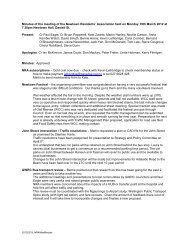Draft Town Belt Management Plan - Wellington City Council
Draft Town Belt Management Plan - Wellington City Council
Draft Town Belt Management Plan - Wellington City Council
Create successful ePaper yourself
Turn your PDF publications into a flip-book with our unique Google optimized e-Paper software.
1980: Former <strong>Town</strong> <strong>Belt</strong> land behind Government House was returned to the <strong>Council</strong>.<br />
1994: The <strong>Council</strong> approved the <strong>Town</strong> <strong>Belt</strong> <strong>Management</strong> <strong>Plan</strong>, which was published in 1995. The<br />
plan provided a policy framework for managing and developing the <strong>Town</strong> <strong>Belt</strong>.<br />
1998: The <strong>Council</strong> approved the <strong>Town</strong> <strong>Belt</strong> Reinstatement Policy, which outlined the <strong>Council</strong>’s<br />
approach to recovering and reinstating land that had been in the original <strong>Town</strong> <strong>Belt</strong>.<br />
1998 to 2008: During this time some of the original sections of the <strong>Town</strong> <strong>Belt</strong> were recovered:<br />
Telecom land, Te Ahumairangi Hill (formerly called Tinakori Hill, 18.63ha) and the former Chest<br />
Hospital (2.4ha).<br />
2009: The Port Nicholson Block (Taranaki Whānui ki Te Upoko o Te Ika) Claims Settlement Act<br />
2009 came into force on September 2, signed by the Crown and the Port Nicholson Block<br />
Settlement Trust (representing descendants of tupuna of Te Ātiawa, Taranaki, Ngāti Ruanui and<br />
Ngāti Tama and holding a kaitiaki role for Ngāti Mutunga).<br />
The nature and development of the <strong>Town</strong> <strong>Belt</strong> since 1842 gives it historic and cultural significance.<br />
It is part of the story of <strong>Wellington</strong>’s development as a city. Its role as a recreation ground means<br />
many of its historic features relate to its landscape and open space character, such as landform<br />
modification, historic plantings, track development and garden development. However, the nature<br />
of <strong>Wellington</strong>’s topography and historical development has also seen <strong>Town</strong> <strong>Belt</strong> land used for<br />
infrastructure and public works purposes, resulting in places of historical significance.<br />
58<br />
Mt Victoria/Matairangi lookout with interpretation panels outlining<br />
the cultural and historical significance of the area<br />
7.3 Sites of interest and historic significance<br />
Wireless Station, Te Ahumairangi Hill. The New Zealand Post Office wireless transmitting<br />
station, initially called Etako (Wi Tako), was opened on 14 October 1912 and the first wireless<br />
communication between New Zealand and Australia was successfully transmitted. The station,<br />
which comprised a 45.75m aerial and a stone building, served as a coast radio station for shipping,<br />
aircraft and lighthouses and for New Zealand’s international telegraph and telephone circuits. It<br />
was modernised in 1924 into a short-wave radio station and further developed in 1939 for Radio<br />
ZLW. It was closed when under Telecom ownership in September 1993.<br />
<strong>Draft</strong> <strong>Town</strong> <strong>Belt</strong> <strong>Management</strong> <strong>Plan</strong> October 2012





